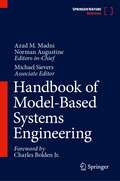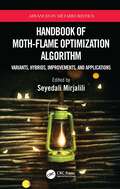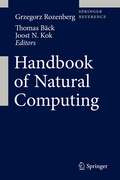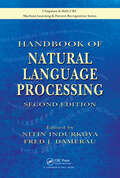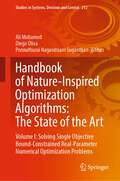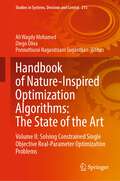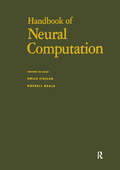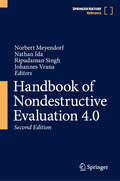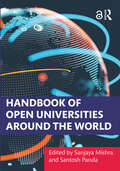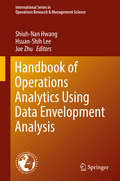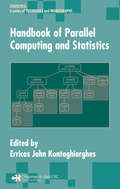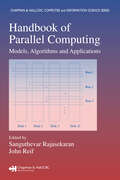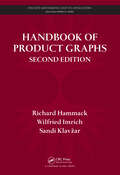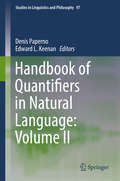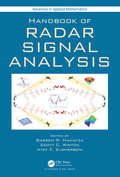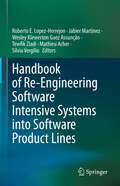- Table View
- List View
Handbook of Model-Based Systems Engineering
by Azad M. Madni Michael Sievers Norman AugustineThis handbook brings together diverse domains and technical competences of Model Based Systems Engineering (MBSE) into a single, comprehensive publication. It is intended for researchers, practitioners, and students/educators who require a wide-ranging and authoritative reference on MBSE with a multidisciplinary, global perspective. It is also meant for those who want to develop a sound understanding of the practice of systems engineering and MBSE, and/or who wish to teach both introductory and advanced graduate courses in systems engineering. It is specifically focused on individuals who want to understand what MBSE is, the deficiencies in current practice that MBSE overcomes, where and how it has been successfully applied, its benefits and payoffs, and how it is being deployed in different industries and across multiple applications. MBSE engineering practitioners and educators with expertise in different domains have contributed chapters that address various uses of MBSE and related technologies such as simulation and digital twin in the systems lifecycle. The introductory chapter reviews the current state of practice, discusses the genesis of MBSE and makes the business case. Subsequent chapters present the role of ontologies and meta-models in capturing system interdependencies, reasoning about system behavior with design and operational constraints; the use of formal modeling in system (model) verification and validation; ontology-enabled integration of systems and system-of-systems; digital twin-enabled model-based testing; system model design synthesis; model-based tradespace exploration; design for reuse; human-system integration; and role of simulation and Internet-of-Things (IoT) within MBSE.
Handbook of Moth-Flame Optimization Algorithm: Variants, Hybrids, Improvements, and Applications (Advances in Metaheuristics)
by Seyedali MirjaliliMoth-Flame Optimization algorithm is an emerging meta-heuristic and has been widely used in both science and industry. Solving optimization problem using this algorithm requires addressing a number of challenges, including multiple objectives, constraints, binary decision variables, large-scale search space, dynamic objective function, and noisy parameters. Handbook of Moth-Flame Optimization Algorithm: Variants, Hybrids, Improvements, and Applications provides an in-depth analysis of this algorithm and the existing methods in the literature to cope with such challenges. Key Features: • Reviews the literature of the Moth-Flame Optimization algorithm • Provides an in-depth analysis of equations, mathematical models, and mechanisms of the Moth-Flame Optimization algorithm • Proposes different variants of the Moth-Flame Optimization algorithm to solve binary, multi-objective, noisy, dynamic, and combinatorial optimization problems • Demonstrates how to design, develop, and test different hybrids of Moth-Flame Optimization algorithm • Introduces several applications areas of the Moth-Flame Optimization algorithm This handbook will interest researchers in evolutionary computation and meta-heuristics and those who are interested in applying Moth-Flame Optimization algorithm and swarm intelligence methods overall to different application areas.
Handbook of Multimedia Information Security: Techniques and Applications
by Amit Kumar Singh Anand MohanThis handbook is organized under three major parts. The first part of this handbook deals with multimedia security for emerging applications. The chapters include basic concepts of multimedia tools and applications, biological and behavioral biometrics, effective multimedia encryption and secure watermarking techniques for emerging applications, an adaptive face identification approach for android mobile devices, and multimedia using chaotic and perceptual hashing function. The second part of this handbook focuses on multimedia processing for various potential applications. The chapter includes a detail survey of image processing based automated glaucoma detection techniques and role of de-noising, recent study of dictionary learning based image reconstruction techniques for analyzing the big medical data, brief introduction of quantum image processing and it applications, a segmentation-less efficient Alzheimer detection approach, object recognition, image enhancements and de-noising techniques for emerging applications, improved performance of image compression approach, and automated detection of eye related diseases using digital image processing. The third part of this handbook introduces multimedia applications. The chapter includes the extensive survey on the role of multimedia in medicine and multimedia forensics classification, a finger based authentication system for e-health security, analysis of recently developed deep learning techniques for emotion and activity recognition. Further, the book introduce a case study on change of ECG according to time for user identification, role of multimedia in big data, cloud computing, the Internet of things (IoT) and blockchain environment in detail for real life applications. This handbook targets researchers, policy makers, programmers and industry professionals in creating new knowledge for developing efficient techniques/framework for multimedia applications. Advanced level students studying computer science, specifically security and multimedia will find this book useful as a reference.
Handbook of Multimedia for Digital Entertainment and Arts
by Borko FurhtThe advances in computer entertainment, multi-player and online games, technology-enabled art, culture and performance have created a new form of entertainment and art. The success of this new field has influenced the development of the digital entertainment industry and related products/services, which has impacted every aspect of our lives. Handbook of Multimedia for Digital Entertainment and Arts is an edited volume contributed by worldwide experts in the field of the new digital and interactive media, and their applications in entertainment and arts. This handbook covers leading edge media technologies, and the latest research applied to digital entertainment and arts. The main focus of Handbook of Multimedia for Digital Entertainment and Arts targets interactive and online games, edutainment, e-performance, personal broadcasting, innovative technologies for digital arts, digital visual and auditory media, augmented reality, moving media, and other advanced topics. The final chapters of this book present future trends and developments within this explosive field. Handbook of Multimedia for Digital Entertainment and Arts serves as a primary reference for advanced-level students, researchers and professors studying computer science and electrical engineering. With the dramatic growth of interactive digital entertainment and art applications, this handbook is also suitable as a reference for practitioners, programmers, and engineers working in this field.
Handbook of Natural Computing
by Thomas Bäck Grzegorz Rozenberg Joost N. KokNatural Computing is the field of research that investigates both human-designed computing inspired by nature and computing taking place in nature, i.e., it investigates models and computational techniques inspired by nature and also it investigates phenomena taking place in nature in terms of information processing. Examples of the first strand of research covered by the handbook include neural computation inspired by the functioning of the brain; evolutionary computation inspired by Darwinian evolution of species; cellular automata inspired by intercellular communication; swarm intelligence inspired by the behavior of groups of organisms; artificial immune systems inspired by the natural immune system; artificial life systems inspired by the properties of natural life in general; membrane computing inspired by the compartmentalized ways in which cells process information; and amorphous computing inspired by morphogenesis. Other examples of natural-computing paradigms are molecular computing and quantum computing, where the goal is to replace traditional electronic hardware, e.g., by bioware in molecular computing. In molecular computing, data are encoded as biomolecules and then molecular biology tools are used to transform the data, thus performing computations. In quantum computing, one exploits quantum-mechanical phenomena to perform computations and secure communications more efficiently than classical physics and, hence, traditional hardware allows. The second strand of research covered by the handbook, computation taking place in nature, is represented by investigations into, among others, the computational nature of self-assembly, which lies at the core of nanoscience, the computational nature of developmental processes, the computational nature of biochemical reactions, the computational nature of bacterial communication, the computational nature of brain processes, and the systems biology approach to bionetworks where cellular processes are treated in terms of communication and interaction, and, hence, in terms of computation. We are now witnessing exciting interaction between computer science and the natural sciences. While the natural sciences are rapidly absorbing notions, techniques and methodologies intrinsic to information processing, computer science is adapting and extending its traditional notion of computation, and computational techniques, to account for computation taking place in nature around us. Natural Computing is an important catalyst for this two-way interaction, and this handbook is a major record of this important development.
Handbook of Natural Language Processing (Chapman & Hall/CRC Machine Learning & Pattern Recognition)
by Nitin Indurkhya Fred J. DamerauThe Handbook of Natural Language Processing, Second Edition presents practical tools and techniques for implementing natural language processing in computer systems. Along with removing outdated material, this edition updates every chapter and expands the content to include emerging areas, such as sentiment analysis.New to the Second EditionGreater
Handbook of Natural Language Processing and Machine Translation: DARPA Global Autonomous Language Exploitation
by Caitlin Christianson Joseph Olive John MccaryThis comprehensive handbook, written by leading experts in the field, details the groundbreaking research conducted under the breakthrough GALE program--The Global Autonomous Language Exploitation within the Defense Advanced Research Projects Agency (DARPA), while placing it in the context of previous research in the fields of natural language and signal processing, artificial intelligence and machine translation. The most fundamental contrast between GALE and its predecessor programs was its holistic integration of previously separate or sequential processes. In earlier language research programs, each of the individual processes was performed separately and sequentially: speech recognition, language recognition, transcription, translation, and content summarization. The GALE program employed a distinctly new approach by executing these processes simultaneously. Speech and language recognition algorithms now aid translation and transcription processes and vice versa. This combination of previously distinct processes has produced significant research and performance breakthroughs and has fundamentally changed the natural language processing and machine translation fields. This comprehensive handbook provides an exhaustive exploration into these latest technologies in natural language, speech and signal processing, and machine translation, providing researchers, practitioners and students with an authoritative reference on the topic.
Handbook of Nature-Inspired Optimization Algorithms: Volume I: Solving Single Objective Bound-Constrained Real-Parameter Numerical Optimization Problems (Studies in Systems, Decision and Control #212)
by Ponnuthurai Nagaratnam Suganthan Diego Oliva Ali MohamedThe introduction of nature-inspired optimization algorithms (NIOAs), over the past three decades, helped solve nonlinear, high-dimensional, and complex computational optimization problems. NIOAs have been originally developed to overcome the challenges of global optimization problems such as nonlinearity, non-convexity, non-continuity, non-differentiability, and/or multimodality which traditional numerical optimization techniques had difficulties solving. The main objective for this book is to make available a self-contained collection of modern research addressing the general bound-constrained optimization problems in many real-world applications using nature-inspired optimization algorithms. This book is suitable for a graduate class on optimization, but will also be useful for interested senior students working on their research projects.
Handbook of Nature-Inspired Optimization Algorithms: Volume II: Solving Constrained Single Objective Real-Parameter Optimization Problems (Studies in Systems, Decision and Control #213)
by Ponnuthurai Nagaratnam Suganthan Diego Oliva Ali Wagdy MohamedThis book presents recent contributions and significant development, advanced issues, and challenges. In real-world problems and applications, most of the optimization problems involve different types of constraints. These problems are called constrained optimization problems (COPs). The optimization of the constrained optimization problems is considered a challenging task since the optimum solution(s) must be feasible. In their original design, evolutionary algorithms (EAs) are able to solve unconstrained optimization problems effectively. As a result, in the past decade, many researchers have developed a variety of constraint handling techniques, incorporated into (EAs) designs, to counter this deficiency.The main objective for this book is to make available a self-contained collection of modern research addressing the general constrained optimization problems in many real-world applications using nature-inspired optimization algorithms. This book is suitable for a graduate class on optimization, but will also be useful for interested senior students working on their research projects.
Handbook of Neural Computation: Supplement 1
by Russell Beale Emile FieslerThe Handbook of Neural Computation is a practical, hands-on guide to the design and implementation of neural networks used by scientists and engineers to tackle difficult and/or time-consuming problems.The handbook bridges an information pathway between scientists and engineers in different disciplines who apply neural networks to similar probl
Handbook of Neuroevolution Through Erlang
by Gene I. SherHandbook of Neuroevolution Through Erlang presents both the theory behind, and the methodology of, developing a neuroevolutionary-based computational intelligence system using Erlang. With a foreword written by Joe Armstrong, this handbook offers an extensive tutorial for creating a state of the art Topology and Weight Evolving Artificial Neural Network (TWEANN) platform. In a step-by-step format, the reader is guided from a single simulated neuron to a complete system. By following these steps, the reader will be able to use novel technology to build a TWEANN system, which can be applied to Artificial Life simulation, and Forex trading. Because of Erlang's architecture, it perfectly matches that of evolutionary and neurocomptational systems. As a programming language, it is a concurrent, message passing paradigm which allows the developers to make full use of the multi-core & multi-cpu systems. Handbook of Neuroevolution Through Erlang explains how to leverage Erlang's features in the field of machine learning, and the system's real world applications, ranging from algorithmic financial trading to artificial life and robotics.
Handbook of Nondestructive Evaluation 4.0
by Nathan Ida Ripudaman Singh Norbert Meyendorf Johannes VranaThis handbook comprehensively covers the cutting-edge trends and techniques essential for the integration of nondestructive evaluation (NDE) into the changing face of the modern industrial landscape. In particular, it delves into the marriage of NDE with new techniques in e.g. data mining, cloud computing and autonomous operation, highlighting the potential for cyber-physical controlled production and discussing the myriad possible applications across many different industries.The Handbook of NDE 4.0 centers around the Internet of Things and Industry 4.0 – the next generation of industrial production encompassing all aspects of networking across all industrial areas. It discusses the adaptation of existing NDE techniques to emerging new technological areas, such as 3D printing, via the introduction of cyber systems into the inspection and maintenance processes. In addition, the handbook covers topics such as the management and processing of big data with respect to real-time monitoring of structural integrity and reliable inspection of individual components. Remote NDE to include competence not available on-site will be a potential technique to increase reliability of NDE inspections by integrating additional specialist inputs into the decision process by methods such as telepresence, thereby better leveraging the scarce resources of senior inspectors into industrial inspections at multiple sites.The handbook houses a wealth of essential information to help academics, industry professionals and entrepreneurs navigate through this burgeoning new field. The material in this handbook is presented with the intention of ultimately improving human safety through reliable inspections and dependable maintenance of critical infrastructure, while also enhancing business value through reduced downtime, affordable maintenance, and talent optimization.
Handbook of Nondestructive Evaluation 4.0
by Nathan Ida Norbert Meyendorf Johannes Vrana Ripudaman Ripi SinghThis handbook, now as second edition, continues to comprehensively cover the cutting-edge trends and techniques essential for the integration of nondestructive evaluation (NDE) into the changing face of the modern industrial landscape. In particular, it delves into the marriage of NDE with new techniques in e.g. data mining and management, cloud computing, autonomous operation, AI for data analysis and decision making, as well as cyber security, highlighting the potential for cyber-physical controlled production and discussing the myriad possible applications across many different industries. The Handbook of NDE 4.0 centers around the Industry 4.0 philosophy – the next generation of industrial production encompassing all aspects of networking across all industrial areas. It discusses the adaptation of existing NDE techniques to emerging new technological areas, such as 3D printing, via the introduction of cyber systems into the inspection and maintenance processes. In addition, the handbook covers topics such as the management and processing of big data with respect to real-time monitoring of structural integrity and reliable inspection of individual components. Remote NDE to include competence not available on-site will be a potential technique to increase reliability of NDE inspections by integrating additional specialist inputs into the decision process by methods such as telepresence, thereby better leveraging the scarce resources of senior inspectors into industrial inspections at multiple sites. The handbook also includes non-technical topics of direct relevance to leadership, management, and adoption of this new philosophy. The handbook houses a wealth of essential information to help academics, industry professionals, regulatory bodies, and entrepreneurs navigate through this burgeoning new field. The material in this handbook is presented with the intention of ultimately improving human safety through reliable inspections and dependable maintenance of critical infrastructure, while also enhancing business value through reduced downtime, affordable maintenance, and talent optimization. The content is positioned to inspire NDE professionals to think broadly in terms of their role as continuous value add rather than discrete decision support. This second edition contains many new chapters, and half of all chapters were revised from the 1st edition, based on the engagement of authors through global platforms such as the ICDNT Specialist International Group on NDE 4.0 and the International conference series on NDE 4.0.
Handbook of Online Learning
by Kjell Erik Rudestam Judith Schoenholtz-ReadThe Handbook of Online Learning is a comprehensive reference text for teachers and administrators of online courses and programs. It presents a discussion of the conceptual and theoretical foundations of online learning along with an exploration of practical implementation strategies. New and Ongoing FeaturesEmphasizes interactive teaching/learning strategies – challenging readers to think differently about pedagogy Provides a strong theoretical base before discussing applications: Part I first presents the changing philosophies and theories of learning, while Part II covers implementation or the practice of online learning Offers several chapters that deal with the issues related to the growing corporate online learning environment Includes twelve NEW articles on the latest issues such as psychology of online learning, training faculty, digital libraries, ethical dimensions in online learning, legal issues, course management systems and evolving technologies. key articles retained from current edition are revised and updated to reflect current trends and changes in the field Praise for the First Edition"The Fielding Institute authors apply an impressive wealth of organizational management theory and experience in their analyses of computer-mediated teaching and learning. The result is an enjoyable-to-read, fresh and lively book, delivering an abundance of ideas about how to establish a supportive learning environment, design a well structured course and manage electronically mediated dialog, -- in other words, how to successfully facilitate learning in the new context of on-line distance education."—Michael G. Moore, Pennsylvania State University and Editor, The American Journal of Distance Education "This book is a fascinating, comprehensive, revealing array of information about online learning. It is full of practical applications and significant implications for a future where online learning will play an increasingly larger role. It is essential for any library keeping up on online learning innovations." —Dr. Bernard J. Luskin, President and Co-CEO, GlobalLearningSystems, Inc. Visiting Professor, Claremont Graduate University"This book not only is that rare breed that addresses online learning in both higher education and corporate environments but every chapter is intriguing, informative, and accurately grounded. This book provides a comprehensive, timely, and informative look at online learning in higher education and corporate training settings. For an update on the state of e-learning in educational and training environments, simply read this book."—Curtis J. Bonk, Ph.D., Indiana University and Courseshare.com"Business and Learning have enjoyed a symbiotic relationship in our culture. The pace of change, however, has created separation between these two vital elements. The "Handbook of Online Learning" showcases the latest thinking and applications in learning delivery, and offers real promise that the gap is being bridged." —D.M. Verkest, AT&T Wireless Services, Vice-President-National Operations "The authors of this book are all experienced distance educators who know what the issues are: How are people engaged in teaching and learning at a distance "present" to one another? How do you create a community in the class? How can a teacher deal with an obstreperous student? What are the teaching/learning environments in universities and corporations as they affect distance education? The essays in this book inhabit the border where the idea of distance education meets the reality. The give practical advice and provide examples informed by both theory and experience."—Stanley Chodorow, Professor Emeritus, University of California, San Diego & Former CEO, California Virtual University
Handbook of Open Universities Around the World
by Santosh Panda Sanjaya MishraThe Handbook of Open Universities Around the World is the first collection to provide a comprehensive and critical overview of open universities internationally. Over 80 open universities have been established across five continents to provide a distance-orientated, class-inclusive, and high-quality education for learners left behind by existing formal systems for higher and continuing education and lifelong learning. This mission has been continually reshaped by major developments in open education, learning technologies, and online social networking, as well as by the evolution of specific concerns such as the massification of education, employability, financial trends, artificial intelligence, and development agendas on the regional, national, and global levels.This landmark volume analyzes and reflects on the planning, organization, management, pedagogic, skilling and employability, and accreditation dimensions of 47 open universities in relation to their national and institutional contexts, the internationalization of education, and the integration of advanced learning technologies. Featuring contributions by internationally recognized scholars, practitioners, and educational administrators, this authoritative resource provides insights into the business model—finances, operations, instructional systems, enrollment patterns, learner supports, quality assurance, professional development, and more—of today’s open universities. Through historical trajectories, institutional profiles, case studies, lessons learned, and best practices, this book provides rich analytical perspectives on the status and challenges of single-mode distance learning universities as an educational phenomenon while unpacking the premise of “openness” itself.This Handbook is primarily written for planners, managers, administrators, instructional designers, and teaching faculty at single-mode distance teaching universities who are seeking to sustain their institutions in a period of rapid change; government policymakers, training organizations, technology providers, and education think tanks who are in need of authentic and research-based information on technology-enabled learning modeled by open universities around the world; and graduate students, teaching faculty, and scholars who are affiliated with online and distance education, learning design and technology, higher education planning and management, adult education and lifelong learning, and education policy and future studies. Chapter 54 of this book is freely available as a downloadable Open Access PDF at http://www.taylorfrancis.com under a Creative Commons Attribution-Non Commercial-No Derivatives (CC BY-NC-ND) 4.0 license.Watch a stimulating discussion between the book's volume editors and Sir John Daniel and Professor Stephen Murgatroyd on YouTube!
Handbook of Operations Analytics Using Data Envelopment Analysis
by Joe Zhu Shiuh-Nan Hwang Hsuan-Shih LeeThis handbook focuses on Data Envelopment Analysis (DEA) applications in operations analytics which are fundamental tools and techniques for improving operation functions and attaining long-term competitiveness. In fact, the handbook demonstrates that DEA can be viewed as Data Envelopment Analytics. Chapters include a review of cross-efficiency evaluation; a case study on measuring the environmental performance of OECS countries; how to select a set of performance metrics in DEA with an application to American banks; a relational network model to take the operations of individual periods into account in measuring efficiencies; how the efficient frontier methods DEA and stochastic frontier analysis (SFA) can be used synergistically; and how to integrate DEA and multidimensional scaling. In other chapters, authors construct a dynamic three-stage network DEA model; a bootstrapping based methodology to evaluate returns to scale and convexity assumptions in DEA; hybridizing DEA and cooperative games; using DEA to represent the production technology and directional distance functions to measure band performance; an input-specific Luenberger energy and environmental productivity indicator; and the issue of reference set by differentiating between the uniquely found reference set and the unary and maximal types of the reference set. Finally, additional chapters evaluate and compare the technological advancement observed in different hybrid electric vehicles (HEV) market segments over the past 15 years; radial measurement of efficiency for the production process possessing multi-components under different production technologies; issues around the use of accounting information in DEA; how to use DEA environmental assessment to establish corporate sustainability; a summary of research efforts on DEA environmental assessment applied to energy in the last 30 years; and an overview of DEA and how it can be utilized alone and with other techniques to investigate corporate environmental sustainability questions.
Handbook of Optical Interconnects (Optical Science and Engineering)
by Shigeru KawaiAs we reach the data transmission limits of copper wire and communications experts seek to bring the speed of long-haul fiber optics networks closer to access points, optical interconnects promise to provide efficient, high-speed data transmission for the next generation of networks and systems. They offer higher bit-rates, virtually no crosstalk, lower demands on power requirements and thermal management, and the possibility of two-dimensional channel arrays for chip-to-chip communication.The Handbook of Optical Interconnects introduces the systems and devices that will bring the speed and quality of optical transmission closer to the circuit board. Contributed by active experts, most from leading technology companies in the US and Japan, this outstanding handbook details various low-cost and small-size configurations, illustrates the discussion with more than 300 figures, and offers a look at the applications and future of this exciting and rapidly growing field. The book includes a detailed introduction to vertical cavity surface-emitting lasers (VCSELs); the use of optical interconnects in metropolitan, local-area, and access networks through FTTP (FTTH); and Jisso technologies, which are critical for developing low-cost, small-size modules.Driving down the size and cost of optical interconnects is vital for integrating these technologies into the network and onto microprocessors, and the Handbook of Optical Interconnects provides the knowledge and tools necessary to accomplish these goals.
Handbook of Optimization in Complex Networks
by Panos M. Pardalos My T. ThaiComplex Social Networks is a newly emerging (hot) topic with applications in a variety of domains, such as communication networks, engineering networks, social networks, and biological networks. In the last decade, there has been an explosive growth of research on complex real-world networks, a theme that is becoming pervasive in many disciplines, ranging from mathematics and computer science to the social and biological sciences. Optimization of complex communication networks requires a deep understanding of the interplay between the dynamics of the physical network and the information dynamics within the network. Although there are a few books addressing social networks or complex networks, none of them has specially focused on the optimization perspective of studying these networks. This book provides the basic theory of complex networks with several new mathematical approaches and optimization techniques to design and analyze dynamic complex networks. A wide range of applications and optimization problems derived from research areas such as cellular and molecular chemistry, operations research, brain physiology, epidemiology, and ecology.
Handbook of Parallel Computing and Statistics (Statistics: A Series of Textbooks and Monographs)
by Erricos John KontoghiorghesTechnological improvements continue to push back the frontier of processor speed in modern computers. Unfortunately, the computational intensity demanded by modern research problems grows even faster. Parallel computing has emerged as the most successful bridge to this computational gap, and many popular solutions have emerged based on its concepts
Handbook of Parallel Computing: Models, Algorithms and Applications (Chapman & Hall/CRC Computer and Information Science Series)
by Sanguthevar Rajasekaran John ReifThe ability of parallel computing to process large data sets and handle time-consuming operations has resulted in unprecedented advances in biological and scientific computing, modeling, and simulations. Exploring these recent developments, the Handbook of Parallel Computing: Models, Algorithms, and Applications provides comprehensive coverage on a
Handbook of Practical Logic and Automated Reasoning
by John HarrisonThe sheer complexity of computer systems has meant that automated reasoning, i. e. the ability of computers to perform logical inference, has become a vital component of program construction and of programming language design. This book meets the demand for a self-contained and broad-based account of the concepts, the machinery and the use of automated reasoning. The mathematical logic foundations are described in conjunction with practical application, all with the minimum of prerequisites. The approach is constructive, concrete and algorithmic: a key feature is that methods are described with reference to actual implementations (for which code is supplied) that readers can use, modify and experiment with. This book is ideally suited for those seeking a one-stop source for the general area of automated reasoning. It can be used as a reference, or as a place to learn the fundamentals, either in conjunction with advanced courses or for self study.
Handbook of Product Graphs (Discrete Mathematics and Its Applications)
by Richard Hammack Wilfried Imrich Sandi KlavžarThis handbook examines the dichotomy between the structure of products and their subgraphs. It also features the design of efficient algorithms that recognize products and their subgraphs and explores the relationship between graph parameters of the product and factors. Extensively revised and expanded, this second edition presents full proofs of many important results as well as up-to-date research and conjectures. It illustrates applications of graph products in several areas and contains well over 300 exercises. Supplementary material is available on the book's website.
Handbook of Quantifiers in Natural Language: Volume II
by Denis Paperno Edward L. KeenanThis work presents the structure, distribution and semantic interpretation of quantificational expressions in languages from diverse language families and typological profiles. The current volume pays special attention to underrepresented languages of different status and endangerment level. Languages covered include American and Russian Sign Languages, and sixteen spoken languages from Africa, Australia, Papua, the Americas, and different parts of Asia. The articles respond to a questionnaire the editors constructed to enable detailed crosslinguistic comparison of numerous features. They offer comparable information on semantic classes of quantifiers (generalized existential, generalized universal, proportional, partitive), syntactically complex quantifiers (intensive modification, Boolean compounds, exception phrases, etc. ), and several more specific issues such as quantifier scope ambiguities, floating quantifiers, and binary (type 2) quantifiers. The book is intended for semanticists, logicians interested in quantification in natural language, and general linguists as articles are meant to be descriptive and theory independent. The book continues and expands the coverage of the Handbook of Quantifiers in Natural Language (2012) by the same editors, and extends the earlier work in Matthewson (2008), Gil et al. (2013) and Bach et al (1995).
Handbook of Radar Signal Analysis (Advances in Applied Mathematics)
by Bassem R. MahafzaThis new handbook on radar signal analysis adopts a deliberate and systematic approach. It uses a clear and consistent level of delivery while maintaining strong and easy-to-follow mathematical details. The emphasis of this book is on radar signal types and their relevant signal processing and not on radar systems hardware or components. This handbook serves as a valuable reference to a wide range of audience. More specifically, college-level students, practicing radar engineers, as well as casual readers of the subject are the intended target audience of the first few chapters of this book. As the book chapters progress, these grow in complexity and specificity. Accordingly, later chapters are intended for practicing engineers, graduate college students, and advanced readers. Finally, the last few chapters contain several special topics on radar systems that are both educational and scientifically entertaining to all readers. The presentation of topics in this handbook takes the reader on a scientific journey whose major landmarks comprise the different radar subsystems and components. In this context, the chapters follow the radar signal along this journey from its birth to the end of its life. Along the way, the different relevant radar subsystems are analyzed and discussed in great detail. The chapter contributors of this new handbook comprise experienced academia members and practicing radar engineers. Their combined years of academic and real-world experiences are in excess of 175. Together, they bring a unique, easy-to-follow mix of mathematical and practical presentations of the topics discussed in this book. See the "Chapter Contributors" section to learn more about these individuals.
Handbook of Re-Engineering Software Intensive Systems into Software Product Lines
by Roberto E. Lopez-Herrejon Jabier Martinez Wesley Klewerton Guez Assunção Tewfik Ziadi Mathieu Acher Silvia VergilioThis handbook distils the wealth of expertise and knowledge from a large community of researchers and industrial practitioners in Software Product Lines (SPLs) gained through extensive and rigorous theoretical, empirical, and applied research. It is a timely compilation of well-established and cutting-edge approaches that can be leveraged by those facing the prevailing and daunting challenge of re-engineering their systems into SPLs. The selection of chapters provides readers with a wide and diverse perspective that reflects the complementary and varied expertise of the chapter authors. This perspective covers the re-engineering processes, from planning to execution.SPLs are families of systems that share common assets, allowing a disciplined software reuse. The adoption of SPL practices has shown to enable significant technical and economic benefits for the companies that employ them. However, successful SPLs rarely start from scratch, but instead, they usually start from a set of existing systems that must undergo well-defined re-engineering processes to unleash new levels of productivity and competitiveness.Practitioners will benefit from the lessons learned by the community, captured in the array of methodological and technological alternatives presented in the chapters of the handbook, and will gain the confidence for undertaking their own re-engineering challenges. Researchers and educators will find a valuable single-entry point to quickly become familiar with the state-of-the-art on the topic and the open research opportunities; including undergraduate, graduate students, and R&D engineers who want to have a comprehensive understanding of techniques in reverse engineering and re-engineering of variability-rich software systems.
